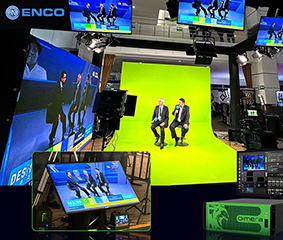Get In Touch
News

ENCO Virtualizes The Captioning Encoding Workflow With Raptor
ENCO has released “another captioning innovation with Raptor, a cloud-based live streaming captioning encoder that injects the speed, power and reliability of real-time, proven AI capabilities into the streaming workflow.

ENCO to Showcase BYOD Translation and Captioning for Live Events at InfoComm
ENCO’s latest award-winning enCaption and enTranslate solutions, including a new mobile-friendly multilingual translation service for in-venue content, demonstrate the company’s vision for AI in AV

ENCO Brings Dynamic Speaker Identification, Live Translations to Mobile into Captioning Environments
New for NAB Show 2025, ENCO’s voice fingerprinting technology breaks new ground in speaker identification; enCaption’s real-time live stage captioning at NAB to be amplified by ENCO’s new on-prem multilingual translation functionality

ENCO to Showcase AI Innovations That Maintain Creativity and Quality in Broadcast Production
ENCO’s fast-growing range of standalone and integrated AI solutions keep the focus on producing quality content that delivers meaningful business results to broadcasters

ENCO Introduces enCaption Sierra System In Las Vegas
LAS VEGAS — It’s an all-in-one Linux or Windows-based product that is designed to improve speed and accuracy for captions and translations on-prem or in the cloud. And, it saw its marketplace debut at the 2024 NAB Show, courtesy of ENCO

ENCO Brings Fast and Accurate Captioning to LTC Public Access TV
Lowell Telecommunications Corp. (LTC), also known as Lowell TeleMedia Center, is a public access TV station in Lowell, Massachusetts that operates three PEG channels. Folks in the community can sign up for a membership to broadcast up to three hours of content per week. Memberships also provide access to equipment rentals and in-studio editing without an additional charge.

ENCO Brings Live Captioning Innovations and Rapid Content Automation for Live Events to ISE 2023
Exhibiting at ISE for the first time, ENCO will showcase its cloud-native enCaption5 captioning software and ClipFire rapid content automation system for a variety of Pro AV environments.

Broadcast Captioning in the UK
When you google broadcast captioning mandates in the U.S., you’re immediately directed to the FCC website where you get tons of information detailing the closed captioning rules and requirements that U.S. broadcasters must follow for both over-the-air and streamed programming. If they fail to comply, there are repercussions, such as penalties and fines.

Complying with Captions in Canada
Whether programs are broadcast via traditional or online platforms, the Canadian Radio-television and Telecommunications Commission (CRTC) takes closed captioning very seriously. In its published guidelines, this regulatory government agency explains the importance of closed captioning.

When Only On-Premises-based Translation Will Do
Real-time captioning has become pervasive as digital content creators strive to make their videos accessible to all, especially the deaf and hard of hearing. While captioning used to be the bailiwick of broadcast TV, it’s now widely available on today’s media fare, including video podcasts, educational videos, and all types of entertainment.

What’s the Difference between Captioning and Transcribing?
While captioning and transcribing videos both involve converting the spoken word into text, the real difference lies in the way they are used. In the case of open and/or closed captioning, the mission is for broadcasters and podcasters to provide on-screen text that displays in sync with the spoken word. In this way, deaf and hard-of-hearing viewers, or those watching with the sound down or off, can follow along.

How TV Captioning Came to Be
Some 48 million Americans suffer from some degree of hearing loss, according to the Hearing Loss Association of America. While broadcast TV captioning was invented with the deaf and hard of hearing in mind, today this service is readily available and beneficial to all.

ENCO enCaption Automated Closed Captioning System Boosts Productivity for U.S. Department of Veterans Affairs
AI-enhanced solution saves time and effort while providing exceptional accuracy in captioning educational content and communications for VA staff and Veterans

ENCO to Showcase Automated Captioning and Transcription Innovations for Pro AV at InfoComm 2022
Demonstrations of upcoming, cloud-native enCaption5 will showcase new efficiencies and powerful enhancements for closed and open captioning, transcription, and translation

Captioning Never Goes Out of Style
Captioning is interwoven into our television, and increasingly, streaming culture. Viewers expect it, and the deaf and hard of hearing depend upon it. In this blog, we’ll look at how government mandates have impacted broadcasting, both over-the-air (OTA) and over the top (OTT).

Four Products for Consideration
Bill Bennett, the Media Solutions Account Manager at ENCO, says the company that pioneered computer-based, digital audio and program automation for radio stations and TV studios have a quartet of products that it is sharing with those who planned on attending the NAB Show.

ENCO’s Patrick Mahon Returns from Plum Tokyo Assignment
Our Television Broadcast Engineer Patrick Mahon just returned from the summer games in Tokyo where he served as a transport signal quality control engineer at the technical operations center (TOC) at Odaiba Marine Park from July 9 to August 7, 2021. This Tokyo venue hosted various competitive sporting events, including aquatics marathon swimming, and triathlon.

Why We Call ClipFire a TV Channel-in-a-Box
Inspired by broadcast television, ClipFire goes a step further, making it possible for a single operator or lean crew to produce and stream professional-looking videos for all kinds of presentations, including online lectures by universities, religious services by churches, and training by corporations.

ClipFire’s Library is Your Greatest Production Asset
ClipFire users can drag and drop media files from the library onto the GUI screen for production or playout using familiar Explorer file lists and ingest media into the library manually or via unmanned DropBox Watch folders. Users can tell ClipFire how to handle newly ingested assets, including assigning file names, categorizing them, and adding metadata for searching.

Making the Most of ClipFire’s Library for Media Playout
As a TV Channel-in-a-Box, ClipFire from ENCO offers a wide range of capabilities essential for live video production, multichannel playout, and streaming, all integrated within this compact, Windows-driven appliance. ClipFire enables users to produce live or pre-recorded videos enhanced by graphics, animations, rolls, crawls, lower third supers, and more while streaming to multiple destinations simultaneously.

The Unstoppable Shift to Broadcast Automation
With its ClipFire TV channel-in-a-box solution, ENCO has integrated mission-critical broadcast capabilities, such as live production, playout, editing, live graphics, media asset management, and more into a compact, Windows-driven appliance.

Foreign Language Captions Add Value to Local TV Content
Presenting information, such as breaking news, with near real-time captions created and translated into one of many foreign languages would make the content more accessible to non-English speaking viewers—provided it can be done cost-effectively.

ClipFire Conveys a Cornucopia of Community Content
If creating visually interesting digital signage takes too much time, effort, or money, or requires integrating third-party systems to aggregate all the necessary tools, the process becomes burdensome for cash-strapped PEG channels. ClipFire solves this dilemma by integrating digital signage creation, asset management, and automated playout capabilities into a compact, software-driven TV Channel-in-a-Box.

ClipFire Delivers for PEG Stations
While community media stations typically operate on tight operating budgets, the reality is that, in order to attract and interest viewers, they must deliver broadcast-quality video programs that meet the expectations of today’s sophisticated media consumer. With its ClipFire TV Channel-in-a-Box, ENCO offers community media an integrated solution that supports their local news and public affairs mission by enabling broadcast-quality video capabilities.

Making Closed Captioning Affordable to PEG Stations
To make local programming accessible to viewers with hearing disabilities, community stations must provide closed captioning that is accurate, complete, legible, and in sync with the spoken dialogue. With its enCaption closed captioning system, ENCO solves this market’s closed captioning challenges.

ENCO enCaption4 Enables Cost Savings and New Automated Captioning Workflows for Civic Center Television in San José
AI-powered solution addresses budget challenges for government access television broadcaster, while integration with Cablecast automation and playout system brings operational benefits
ENCO Systems builds video solutions on top of a Medialooks video SDK
The company’s focus, however, is on the live aspect of closed captioning—ENCO provides one of the few solutions that converts speech to text within a couple of seconds that can be displayed on a screen during a live event or within a web stream. They are now partnering with another Medialooks customer, RUSHWORKS, to provide a tight integration with their video production solutions by leveraging the built-in data transfer approach available in the Medialooks SDK, alleviating the need for additional hardware.
ENCO Appoints Shane Finch as Sales Director for Broadcast and Pro AV Products
Long-time radio professional will emphasize remote broadcasting solutions and “evangelize” benefits of ENCO’s automated workflow solutions for new markets, including open captioning in AV environments

Tightrope and ENCO Forge Partnership to Bring Automated Closed Captioning to Cablecast Community Media Workflows
Brings together flexible and efficient Cablecast automation, playout and publishing platform with machine learning powered enCaption system in cost-effective, end-to-end workflows
enCaption Wins Future Product Innovation Award, Presented by TV Technology
enCaption, a turn-key solution for providing around-the-clock generation of captioning on live or recorded programming, is a recipient of Future’s Product Innovation Award presented by TV Technology.
SVG Blog: ENCO Pushes enTranslate Automated Live Translation, Captioning System
Combining the powerful speech-to-text engine from ENCO’s patented, market-leading enCaption automated captioning solution with advanced translation algorithms, enTranslate provides near-real-time translation of live or pre-recorded content for alternative-language closed captioning, subtitling, and more.







































